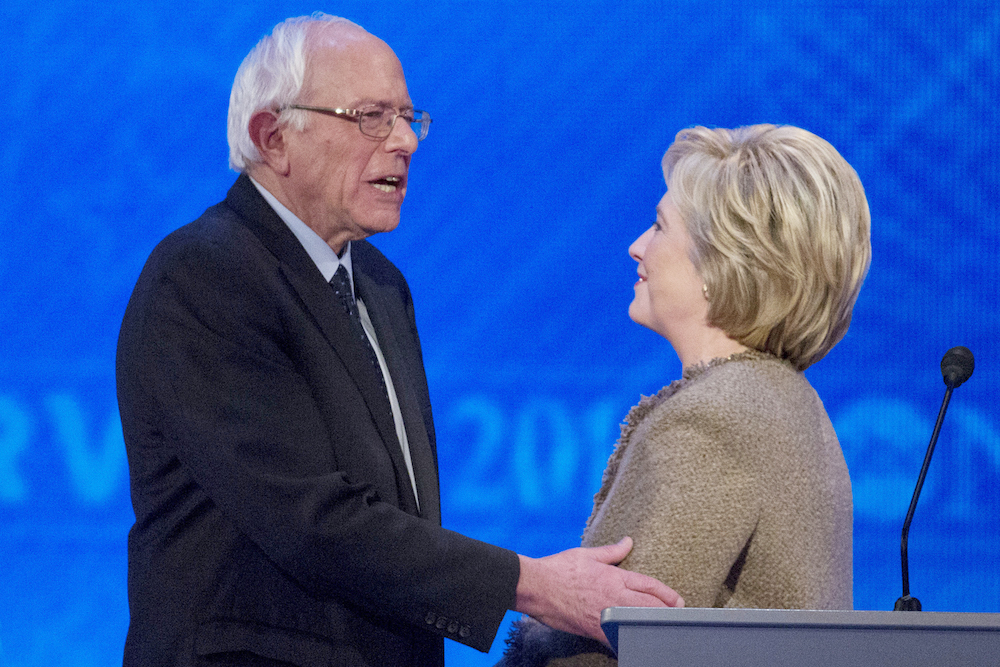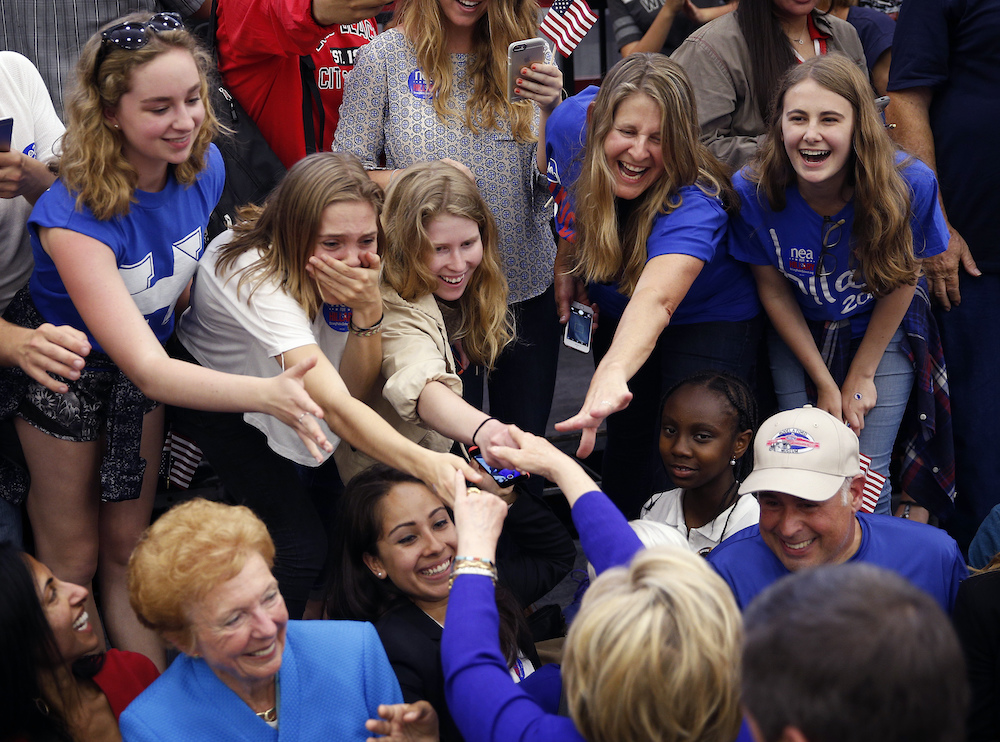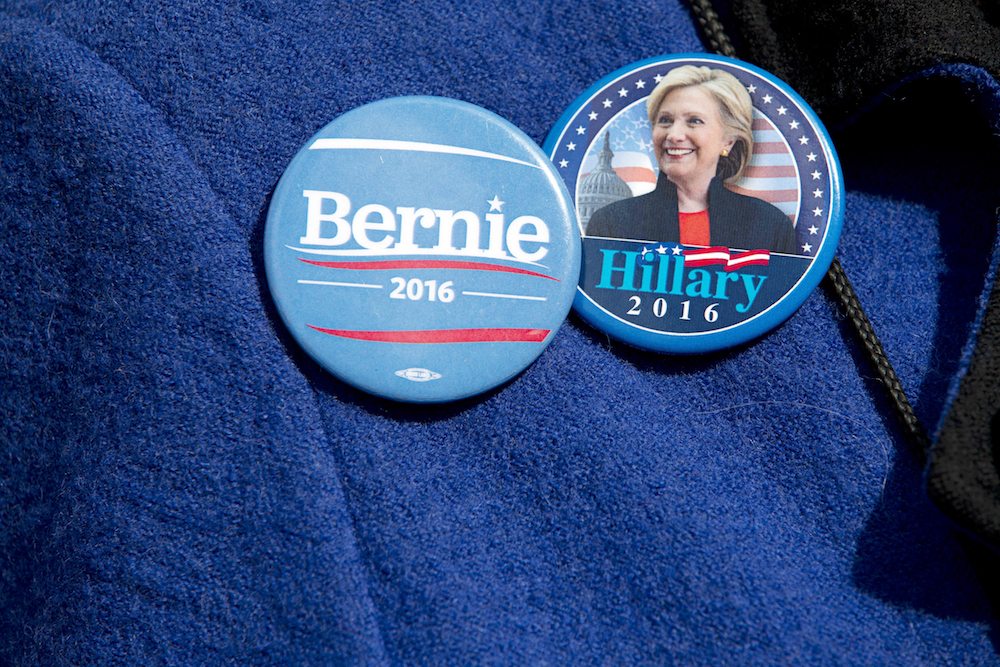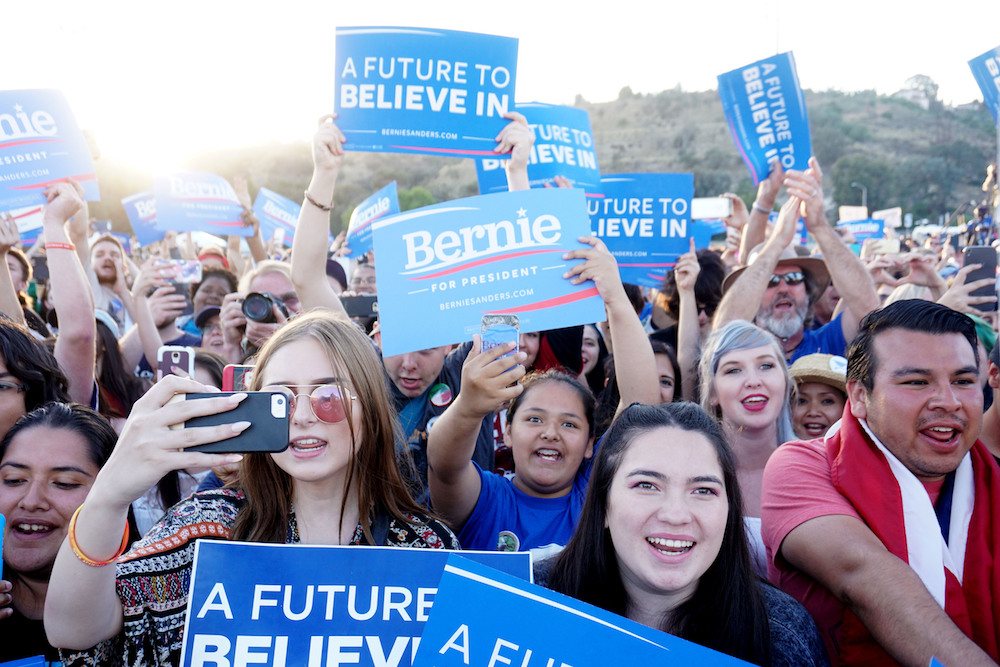Hillary Clinton has made history. But now that she has secured the Democratic presidential nomination, can she make nice?
For most of the primary campaign, the Democrats’ divisions were obscured by the noisy Republican race. The candidates did not insult each other’s spouses, make crude anatomical jokes or link family members to the assassination of John F. Kennedy. Cries of “Bernie or bust!” were easily drowned out by “Never Trump.”
When Bernie Sanders was handed the opportunity to highlight the fact that his opponent was under FBI investigation on the debate stage, he instead memorably insisted he was tired of hearing about her “damn emails” and wound up high-fiving her instead.
But just because the Democratic race was more civil than the Republicans’ doesn’t mean that the divisions aren’t real. The contest got progressively nastier as it went on and reverberated throughout the liberal commentariat, widening the split between Clinton and Sanders supporters.
You had Clinton surrogates, including a sitting United States senator, say they felt threatened by Sanders’ supporters’ behavior at the Nevada Democratic convention. The state party chairwoman received death threats.
Sanders said Clinton was “unqualified” to be president, mistakenly believing she had said the same about him first. Clinton said Sanders had no way of paying for his domestic proposals and that his foreign policy literally made no sense.
Some of this is just typical campaign rhetoric. Chris Christie said Donald Trump lacked the temperament to be president before that became a major Clinton talking point. Now he is one of Trump’s biggest cheerleaders among Republican elected officials.
George H.W. Bush referred to Ronald Reagan’s economic program as “voodoo economics” before serving eight years as his loyal vice president and then essentially running for Reagan’s third term in 1988.
The extent to which Sanders went to war against a Democratic National Committee he regarded as stacking the deck in favor of Clinton was unusual, however.
Sanders and the DNC battled over the number of debates and when they would be scheduled, access to party-controlled voter data and engaged in numerous tactical disputes. Sanders has gone so far as to back the Democratic primary challenger for DNC Chairwoman Debbie Wasserman Schultz’s Florida congressional seat.

Sanders has escalated his criticism of Clinton as his path to the nomination grew more and more implausible. (AP Photo)
Sanders has also escalated his criticism of Clinton as his path to the nomination grew more and more implausible. He is 74 and has less to lose than ambitious vanquished rivals such as Martin O’Malley. His activists are young and inexperienced. Their perceptions that the primary process was “rigged” against them, which Trump works overtime to reinforce, may not fade as easily as it would for more seasoned Democrats.
“The false hope Sanders has been giving them may make it harder to unify the party,” Republican strategist Ford O’Connell told the Washington Examiner. Democrats have no winner-take-all states, so Clinton kept winning delegates even when she lost primaries and caucuses, and the large number of party leaders who get to serve as unbound “superdelegates” always made Sanders’ math daunting.
Rank-and-file Republicans gravitated toward Trump after he won the bruising GOP primary. This helped him close a double-digit deficit in most national polls to start running even with Clinton. The Democrats are looking to party unity to help them regain their lead, right as Republican elected officials appear to be experiencing buyer’s remorse about Trump (of whom they were never really enamored in the first place).
It’s a change Democrats sorely need. Public Policy Polling, a Democratic firm, found Trump and Clinton tied at 44 percent in Pennsylvania. Throw in Libertarian Party nominee Gary Johnson and left-wing Green Party candidate Jill Stein and Clinton leads Trump by just 1 percentage point, 41-40 percent. Pennsylvania is a key state Trump is targeting to turn red in November.
“Republicans are more unified around Trump (79/8) than Democrats are around Clinton (75/15),” Public Policy Polling’s Tom Jensen wrote about the results. “That dynamic is what’s making the state competitive.” Clinton can make Pennsylvania a safer Democratic state by winning over Sanders’ voters.
“If Clinton could win over even just half of those Sanders-supporting holdouts, her lead over Trump would go from a tenuous 41-40 to a comfortable 47-40,” Jensen added. “Whether it’s possible for her to do that, time will tell.”
Democrats are confident Clinton will be able to do just that. “Once Bernie endorses Hillary, most will go along,” Democratic strategist Brad Bannon told the Washington Examiner. “A few of them will end up voting for Jill Stein.” Most Democrats the Examiner spoke to expressed optimism that Trump’s overtures to Sanders voters will fail.
“Democratic defections will be pretty manageable compared to what’s been going on with Trump,” Bannon said. “When push comes to shove, there will be more Democrats voting for Hillary than Republicans voting for Trump.”

Democrats are confident Clinton will be able to win over at least half of those Sanders-supporting holdouts. (AP Photo)
History supports this thesis. In 2008, exit polls in battleground states Indiana and North Carolina showed half of Clinton voters saying they would not support Barack Obama for president. By comparison, nearly half of Sanders’ West Virginia voters this year said they would vote for Trump in November.
There was even a group called PUMAs — “Party Unity My Ass” — who angrily protested that Obama and sexist national Democrats cheated Clinton out of the nomination. Then he chose Joe Biden, a white man who did poorly in the primaries that year, as his running mate. Some said they were willing to vote for John McCain, potentially a factor in his choice to add Sarah Palin to the ticket.
“What we are really organizing about is to reinitiate Hillary back into the presidential race,” one Clinton dead-ender told CNN at the time. Another said the process that nominated Obama over Clinton, who won the popular vote if you counted Michigan, where Obama wasn’t on the ballot, was an “internal coup.”
The big PUMA rally at the 2008 Democratic National Convention was a sparsely attended bust. Obama won 89 percent of Democrats in November in one of the party’s biggest victories in decades, their first absolute majority of the popular vote since 1976.
More recently, “Never Trump” supporters consistently overestimated how much anti-Trump animus within the party would persist once Clinton rather than Ted Cruz was the only other choice. “Despite what opponents of Clinton and Trump might want to believe, neither candidate is particularly unpalatable to their party, when compared with their rivals,” writes Huffington Post polling guru Ariel Edwards-Levy.
The Democrats have plenty of elected officials falling in line to reinforce party unity, with President Obama leading off the string of Clinton endorsements just hours after meeting with the Vermont senator at the White House. Sen. Elizabeth Warren, D-Mass., is also a big endorsement, since she represents Sanders’ wing of the party.
“I think it’s been pretty clear since literally the day she gave her foreign policy speech that everyone in the party is turning their focus to Trump-Clinton. Not a lot of oxygen left for Clinton-Sanders,” Democratic consultant Joe Trippi told the Examiner.
Trippi, who managed Howard Dean’s 2004 presidential campaign, argued that Clinton could even benefit from Sanders’ campaign by adding to the base of progressive small donors that began with Dean’s run.

The concern some have is that some Sanders supporters don’t see themselves as partisan Democrats. (AP Photo)
“Thirteen million people gave to Obama over the two elections,” he said. “We’ve built a massive network of low-dollar donors and Sanders has added to it. Sanders was the big beneficiary of that in the primaries.” Now Clinton can tap into that network in the general election once she is running against Trump rather than a Democrat to her left.
The concern some have is that some Sanders supporters don’t see themselves as partisan Democrats. The senator himself won all his elections before this year’s primaries as an independent. He has caucused with the Democrats in Congress, but has more frequently been the nominee of small Vermont third parties. He did well among independents throughout the campaign.
When Nevada Democrats blamed Sanders supporters for inciting a riot at their state convention, they warned the DNC that they might do the same at the national convention in Philadelphia this summer.
“Having seen up close the lack of conscience or concern for the ramifications of their actions — indeed, the glee with which they engaged in such destructive behavior — we expect similar tactics at the national convention in July,” wrote the Nevada Democrats’ counsel in May.
“I think it would be most regretful if there becomes a schism,” Sen. Dianne Feinstein, D-Calif., said at the time. “That’s what Donald Trump should want: a schism in our party … It’s the responsibility particularly of Sen. Sanders to see that that doesn’t happen.”
When Sanders mentioned having a gracious telephone conversation with Clinton while addressing supporters in Santa Monica, Calif., the crowd booed. Sanders did not do anything to silence them and reiterated his vow to keep fighting until Philadelphia.
“Certainly Sanders can be if he wants to be a disruptive force at the convention,” Trippi said. “Clearly if Bernie wants to take it there, he has enough delegates to make it possible.” But he recalled the “hand-to-hand combat for votes” between Ted Kennedy and Jimmy Carter at the 1980 Democratic convention, and there’s “no, zero, zip, none of that happening” this year so far.
Sanders has said all the right things about the need to beat Trump in the fall. “Needless to say, I am going to do everything in my power and I will work as hard as I can to make sure that Donald Trump does not become president of the United States,” he remarked outside the White House last week, offering to meet with Clinton “to see how we can work together to defeat Donald Trump.”
There are other ways for Sanders to leave a mark on the party besides confrontation. “The platform is his price for going quietly into the good night,” Bannon said.
The DNC allowed Sanders to appoint as many members of the platform committee as Clinton, although he claimed they vetoed a labor union leader he wanted to include. But his appointments, Trippi noted, are “not people you’ve never heard of or who are just going to roll over.”
While the Democrats have some ideological divisions, much of the divide seen during the primaries was based on age and race.

While the Democrats have some ideological divisions, much of the divide seen during the primaries was based on age and race. Sanders did well with millennial voters, who are a rapidly growing demographic. (AP Photo)
Sanders did well with millennial voters, who are a rapidly growing demographic for Democrats. But Latinos are growing even faster. Blacks and Hispanics delivered Clinton the nomination, although Sanders did better among the youngest voters in both groups.
“Bernie has galvanized a whole new generation of political activists,” Bannon said. “That is going to be his lasting legacy.” But his coalition wasn’t diverse enough this year.
This, combined with lingering policy arguments over Bill Clinton’s business-friendly centrist legacy, fueled some of the nastiness in this year’s Democratic race.
Not only did Sanders tie Hillary Clinton to some of her husband’s ideological transgressions — welfare reform, the crime bill, financial deregulation that partially repealed Glass-Steagall — but his assaults on her Iraq War vote and paid Wall Street speeches are rooted in some of those older debates.
The supporters got more heated than the candidates. Progressive blogger Matt Bruenig called Clintonite Center for American Progress President Neera Tanden “scumbag Neera,” who along with the Nation’s Joan Walsh were “geriatrics.”
The two sides often clashed over whether race and gender identity were more important than class. The “Bernie bros'” online reputation was exceeded only by the nastier Trump trolls. “For women and people of color who have tangled with Bruenig, his righteously wielded personal invective comes on top of the online abuse they already suffer,” wrote Slate’s Michelle Goldberg.
Perhaps none of this will play out at the Democratic convention, which could easily turn into a big party celebrating both Sanders’ improbable campaign success and Clinton’s achievement in moving one step closer to shattering the last glass ceiling.
Clinton’s campaign slogan of “stronger together” could apply to the Democrats, too. Clinton gives them an opportunity to follow the first African-American president with the first woman, and socialist Sanders helps the party become more homogenously liberal.
“He got Hillary Clinton to move significantly to the left,” Bannon said. “Bernie Sanders won every battle but lost the war. He did everything he wanted to do except win the nomination.”
Maybe his supporters will conclude that’s good enough.

